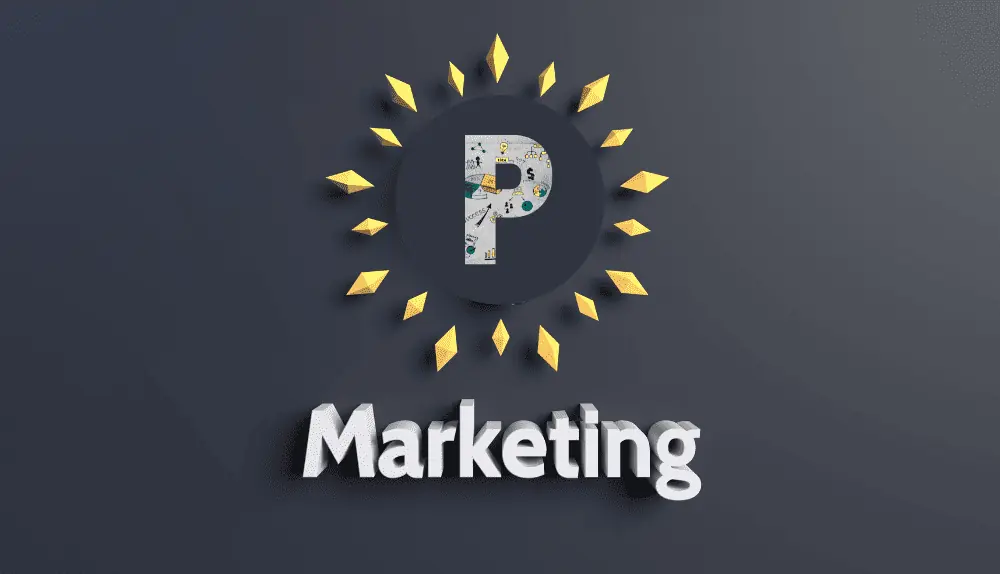In a bustling world of products and services, where competition is fierce, and attention spans are fleeting, successful marketers wield a powerful arsenal of strategies to captivate their audience. Among these, a steadfast foundation has been laid by the “4 Ps of Marketing” – a timeless framework that serves as the compass guiding businesses towards prosperity.
These four pillars, often referred to as the marketer’s golden formula, offer a roadmap for crafting winning marketing strategies that resonate with consumers, making it an indispensable tool for companies striving to stay ahead in an ever-evolving landscape. So, let’s dive into the enchanting realm of marketing and unlock the secrets behind the 4 P’s that can transform mere ideas into awe-inspiring brands with unwavering allure.
What are the 4 P’s of Marketing?

The 4 P’s of marketing, also known as the marketing mix, are a fundamental framework used by businesses to create and implement effective marketing strategies. They were introduced by E. Jerome McCarthy in the 1960s and have since become a cornerstone of marketing theory and practice.
Product
The first “P” focuses on the product or service a company offers to its target customers. This involves understanding and developing products that meet the needs and desires of the target market. Marketers must consider features, quality, design, branding, and packaging to ensure their product stands out in the competitive landscape.
Price
The second “P” involves determining the pricing strategy for the product or service. Pricing decisions should align with the value perceived by customers while also considering production costs, competitor pricing, and overall market conditions. Striking the right balance between perceived value and affordability is critical for successful pricing.
Place
The third “P” emphasizes the distribution and placement of the product. Marketers need to decide on the most appropriate channels to make their products accessible to the target audience. This could involve physical stores, online platforms, or a combination of both, depending on customer preferences and market trends.
Promotion
The fourth “P” focuses on the promotional activities used to communicate the product’s benefits and persuade customers to make a purchase. This includes advertising, public relations, sales promotions, and other communication efforts. The goal is to create awareness, generate interest, and ultimately drive sales.
By carefully considering and balancing these four elements, businesses can develop comprehensive marketing strategies that effectively reach and engage their target audience, leading to increased sales and long-term success.
Understanding the 4 P’s of Marketing
In the realm of marketing, the 4 P’s, also known as the marketing mix, represent a fundamental framework that lays the groundwork for successful business strategies. Developed by E. Jerome McCarthy in the 1960s, these four pillars – Product, Price, Place, and Promotion – are essential components that help marketers shape and implement their plans effectively.
Product: Crafting the Core Offering
The first “P” in the marketing mix is Product. This element revolves around understanding and developing the core offering – the product or service that a company brings to the market. To ensure success, marketers must conduct thorough research to comprehend their target customers’ needs, preferences, and pain points. By aligning the product with these insights, businesses can create offerings that cater directly to their customers’ demands.
Key considerations in the product phase include defining product features, quality, design, and branding. Additionally, product packaging plays a crucial role in influencing consumer perception and setting the product apart from competitors. A well-crafted product strategy can foster brand loyalty and lead to a competitive advantage in the market.
Price: Determining Value and Affordability
The second “P” stands for Price, and it is all about determining the right pricing strategy for the product or service. Pricing decisions should be based on a thorough analysis of various factors, including production costs, market demand, competitor pricing, and the perceived value of the product in the eyes of the target customers.
Finding the right balance between perceived value and affordability is crucial. A pricing strategy that aligns with the target market’s willingness to pay can lead to increased sales and higher profitability. Additionally, marketers must be mindful of pricing adjustments over time, considering factors such as product lifecycle, market conditions, and customer feedback.
Place: Reaching the Right Audience
The third “P” in the marketing mix is Place, which refers to the distribution and placement of the product or service. It involves determining the most appropriate channels to make the product accessible to the target audience. This could include physical stores, online platforms, wholesalers, retailers, or a combination of distribution channels.
Understanding the target market’s purchasing behavior and preferences is vital in selecting the right distribution channels. Marketers need to ensure that the product is available at the right place and at the right time to meet customer demand effectively.
Promotion: Communicating and Persuading
The fourth and final “P” is Promotion. This aspect of the marketing mix involves the promotional activities used to communicate the product’s benefits and persuade customers to make a purchase. Marketers employ various strategies such as advertising, public relations, sales promotions, and personal selling to create brand awareness and generate interest in the product.
Promotion plays a crucial role in capturing the attention of potential customers and converting interest into sales. An effective promotional campaign should be tailored to the target audience and aligned with the overall marketing objectives.
The 4 P’s of marketing provide a comprehensive and time-tested framework for marketers to create successful marketing strategies. By understanding and carefully balancing these four elements – Product, Price, Place, and Promotion – businesses can enhance their market presence, effectively engage their target audience, and ultimately drive sales and success in the competitive business landscape.
How to Use the 4 P’s of Marketing in Your Marketing Strategy

Using the 4 P’s of marketing in your marketing strategy involves a systematic and thoughtful approach to ensure your products or services effectively meet your target customers’ needs and create a strong market presence. Here’s a step-by-step guide on how to incorporate the 4 P’s into your marketing strategy:
Product: Understand Your Customers and Develop a Winning Offering
Start by conducting in-depth market research to understand your target audience’s preferences, pain points, and desires. This will help you create a product or service that addresses their specific needs and differentiates itself from competitors. Focus on product features, quality, design, and branding to ensure your offering appeals to your target customers.
Price: Set the Right Pricing Strategy
Analyze your production costs, competitor pricing, and market demand to determine the optimal price for your product or service. Consider the perceived value of your offering in the eyes of your customers and their willingness to pay. Strive to find the right balance between affordability and perceived value to attract your target market while maintaining profitability.
Place: Select the Most Suitable Distribution Channels
Identify the distribution channels that align with your target audience’s shopping habits and preferences. Whether it’s physical stores, online platforms, wholesalers, or retailers, ensure your product is readily available at the right place and time. Establish strong partnerships with distributors or retailers to enhance the accessibility and visibility of your offering.
Promotion: Communicate and Engage with Your Audience
Develop a comprehensive promotional strategy to create awareness and generate interest in your product or service. Utilize various promotional channels, including advertising, social media, content marketing, public relations, and personal selling, to effectively communicate your brand’s message. Tailor your promotional efforts to resonate with your target audience, emphasizing the unique selling points of your offering.
Continuous Monitoring and Adaptation
Marketing is an ever-evolving process, and monitoring your strategy’s performance is crucial. Keep a close eye on sales, customer feedback, market trends, and competitor activities. Use data analytics to gain insights into your customers’ behaviors and preferences. Based on the feedback and data gathered, be prepared to adapt and fine-tune your marketing mix as needed to stay relevant and competitive in the marketplace.
Integrating the 4 P’s of marketing into your marketing strategy provides a solid foundation for success. By understanding your customers’ needs, developing a compelling product, setting the right price, selecting appropriate distribution channels, and communicating effectively through promotions, you can create a powerful marketing mix that resonates with your target audience and propels your business toward long-term success. Remember to continuously evaluate and adjust your strategy to stay ahead in the ever-changing business landscape.
How 4 P’s Can Help Enhance Your Marketing Strategy?
The 4 P’s of marketing (Product, Price, Place, and Promotion) serve as a powerful toolset to enhance your marketing strategy in various ways. By leveraging these elements effectively, businesses can develop more targeted, customer-centric, and successful marketing approaches. Here’s how each of the 4 P’s can contribute to enhancing your marketing strategy:
Product
- Meeting Customer Needs: Understanding your target audience’s preferences and pain points allows you to develop products or services that directly address their needs, increasing the chances of adoption and satisfaction.
- Differentiation: Focusing on product features, design, and branding enables you to create a unique value proposition that sets your offering apart from competitors, making it more attractive to potential customers.
- Building Brand Loyalty: A well-crafted product strategy that consistently delivers value and meets customer expectations fosters brand loyalty, leading to repeat purchases and positive word-of-mouth marketing.
Price
- Maximizing Profitability: Determining the optimal pricing strategy ensures that your products generate revenue while considering production costs and market demand, thus maximizing profitability.
- Value Perception: Setting the right price creates a perception of value for your customers, influencing their purchase decisions and willingness to pay.
- Competitive Advantage: Strategic pricing can give you a competitive edge, making your products more appealing than those offered by rivals.
Place
- Efficient Distribution: Selecting appropriate distribution channels ensures your products reach your target customers in a timely and convenient manner, increasing accessibility and sales potential.
- Geographic Reach: An effective place strategy enables you to expand your market reach and tap into new customer segments in different regions or countries.
- Channel Partner Collaboration: Building strong relationships with distributors or retailers can enhance visibility and customer engagement with your products.
Promotion
- Creating Awareness: Promotional efforts such as advertising and content marketing help raise awareness about your brand and offerings among your target audience.
- Engagement and Interest: Effective promotion generates interest and engagement, piquing the curiosity of potential customers and driving them to learn more about your products.
- Building Brand Identity: Consistent promotion reinforces your brand identity and message, establishing trust and credibility in the minds of consumers.
The 4 P’s of marketing play a crucial role in enhancing your marketing strategy by guiding you to understand your customers’ needs, craft compelling products, set competitive prices, and develop efficient distribution and promotional tactics. By integrating these elements seamlessly and continuously monitoring and adapting your strategy, you can create a robust and customer-focused marketing approach that leads to increased brand awareness, customer loyalty, and improved business performance.
What Businesses Can Use the 4 P’s of Marketing?
The 4 P’s of marketing (Product, Price, Place, and Promotion) are versatile and can be applied to various types of businesses across different industries. Whether it’s a small startup, a large corporation, a service-based company, or a retail business, the 4 P’s provide a foundational framework for developing effective marketing strategies. Here are some examples of businesses that can use the 4 P’s:
Consumer Goods Companies
Businesses that produce and sell tangible products, such as food and beverages, clothing, electronics, and household items, can use the 4 P’s to tailor their offerings to specific target markets and create compelling marketing campaigns.
Technology Companies
Companies in the tech industry, such as software developers, hardware manufacturers, and IT services providers, can utilize the 4 P’s to design and promote innovative products, set competitive pricing, and choose appropriate distribution channels.
Retailers
Both brick-and-mortar and online retailers can use the 4 P’s to curate their product selections, determine pricing strategies, optimize store or website locations, and implement effective promotional activities to attract and retain customers.
Hospitality and Tourism
Hotels, resorts, airlines, and travel agencies can leverage the 4 P’s to design attractive travel packages, set competitive pricing, choose strategic locations, and promote their services to potential travelers.
Financial Services
Banks, insurance companies, and investment firms can use the 4 P’s to develop and promote various financial products, set fees and interest rates, select convenient branch locations, and execute effective marketing campaigns.
Professional Services
Businesses offering services like legal, accounting, consulting, and marketing can utilize the 4 P’s to communicate their expertise, set competitive pricing for their services, and reach target clients through appropriate channels.
Healthcare Providers
Hospitals, clinics, and medical practitioners can apply the 4 P’s to optimize their services, determine pricing for medical procedures, ensure convenient locations for patients, and promote health awareness campaigns.
Fast-Food Chains
Restaurants and fast-food chains can use the 4 P’s to design appealing menus, set competitive pricing, choose strategic locations for their outlets, and run promotional campaigns to attract customers.
Automotive Industry
Car manufacturers and dealerships can employ the 4 P’s to design and promote vehicles, set competitive pricing, choose dealership locations, and create marketing campaigns that highlight the features and benefits of their cars.
E-commerce Companies
Online businesses can apply the 4 P’s to curate their product offerings, set competitive pricing, optimize their website’s user experience, and implement effective digital marketing strategies.
Overall, virtually any business that aims to succeed in the market can benefit from incorporating the 4 P’s of marketing into their strategies. By understanding their customers, developing compelling products, setting competitive pricing, choosing appropriate distribution channels, and implementing effective promotional efforts, businesses can enhance their market presence and achieve sustainable growth.
Final Words
In conclusion, the 4 P’s of marketing – Product, Price, Place, and Promotion – serve as a timeless and indispensable framework for businesses striving to thrive in today’s competitive landscape. Companies can create customer-centric marketing strategies that resonate with their audience and drive success by understanding their target audience, crafting products that meet specific needs, setting competitive pricing, choosing appropriate distribution channels, and executing effective promotional campaigns.
Whether it’s a consumer goods company, a tech startup, a retail business, or a service provider, the 4 P’s provide a versatile and comprehensive approach to enhancing marketing efforts. Continuously monitoring market trends, customer feedback and adapting strategies accordingly will further ensure businesses stay relevant and maintain a competitive edge.
Ultimately, embracing the 4 P’s enables businesses to create powerful and impactful marketing strategies that lead to increased brand awareness, customer loyalty, and sustainable growth in the ever-evolving world of marketing.
Frequently Asked Questions (FAQs)
Why are the 4 P's of marketing important?
The 4 P's provide a structured approach to understanding and satisfying customer needs, setting competitive prices, selecting appropriate distribution channels, and effectively promoting products or services. They help businesses create customer-centric strategies and achieve their marketing objectives.
How do the 4 P's of marketing work together?
The 4 P's are interconnected, and their effective coordination ensures a comprehensive marketing strategy. Understanding customer needs (Product) helps in determining the right pricing (Price) and selecting suitable distribution channels (Place), while effective promotion (Promotion) communicates the product's value and benefits to the target audience.
Are the 4 P's of marketing applicable to all businesses?
Yes, the 4 P's are applicable to a wide range of businesses across various industries. Whether a business offers products or services, operates in the retail sector or online market, or is a startup or established corporation, the 4 P's can be tailored to suit its unique marketing needs.
How can businesses use the 4 P's to stand out from competitors?
Businesses can use the 4 P's to differentiate themselves from competitors by developing unique products, offering competitive pricing, providing exceptional customer service and distribution, and implementing creative and impactful promotional campaigns that set them apart in the market.
Can the 4 P's be applied to digital marketing?
Yes, the 4 P's are equally relevant in digital marketing. For online businesses, the product can be a digital service or software, the pricing can be dynamic and responsive to real-time data, the place involves selecting online platforms and websites, and the promotion can include social media marketing, content marketing, and other digital channels.
How can small businesses benefit from the 4 P's of marketing?
The 4 P's offer small businesses a structured approach to market their products or services effectively. By understanding their target audience, creating unique offerings, setting competitive prices, and utilizing cost-effective promotional strategies, small businesses can compete with larger competitors and reach their target customers efficiently.
Are the 4 P's of marketing applicable only to for-profit businesses?
No, the 4 P's are relevant to both for-profit and non-profit organizations. Non-profits can use the 4 P's to effectively promote their causes, set donation strategies, engage with their target audience, and maximize the impact of their campaigns.


